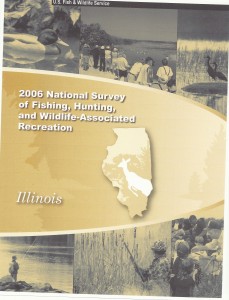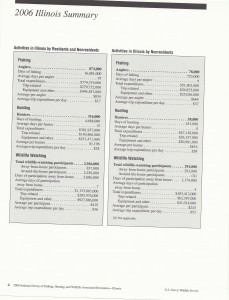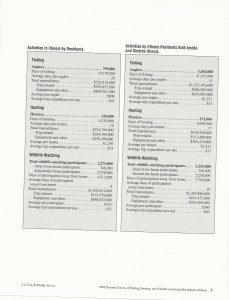Economic Impact of Parks and Recreation
Economic Impact of State and Local Parks Summaries for 14 states, including Alabama, Arkansas, Connetticut, Virginia, Georgia, Illinois, Iowa, Kentucky, Minnesota, Missouri, Nebraska, Pennslyvania, Virginia and Wisconsin which have been submitted to NASORLO are either summarized below or can be found in the attachments. In addition, economic data for an additional 20 states, including Alaska, Arizona, California, North Carolina, Colorado, New Hampshire, Idaho, Louisiana, Maine, New Mexico, Montana, Nevada, New York, Oregon, Tennessee, Utah, Vermont, Washington, Wisconsin, West Virginia and Wyoming can be found in the Research area of the Outdoor Industry website at www.outdoorfoundation.org . [ This website will have specific data on economic impacts of outdoor recreation for ALL STATES, this spring. Keep checking this website ]
MISSOURI.
A recent study by the University of Missouri showed the economic benefit of state parks exceeding one half billion dollars annually. This economic impact supported over 500 jobs in the economy. Local parks and events
also contribute as they annually host hundreds of events and tournaments. Data shows that the development of facilities and areas from the investment of funds from the LWCF State Assistance program pays off for Missouri.
VIRGINIA
RIVirginia’s 35 state parks had more than 8.1 million visits and more than 1 million overnight visits in 2010 – double what it was a decade ago. Economic models estimate that our park visitors contribute more than $180 million andn2,800 jobs to the state’s economy last year.
Taxpayer funding for our parks was less than $17 million during that
same period, which means Virginia is enjoying more than a 10 fold return on its operational investment. Our state parks are a vital component of the
outdoor recreation and tourism industry that is critical to the state’s
economy.
MINNESOTA
Impact on local economies of visitors to Minnesota state parks:
In 2010, Minnesota State Park visitor spending contributed over $233 million to local economies. This figure is based on state park attendance data and spending data collected from a statistically valid survey of spending by people visiting state parks. The spending figure excludes payments to government – such as daily and annual state park vehicle permits, camping and lodging fees paid to the state, and merchandise purchased at a state park. In 2010, day-users spent $26.01 per person per day in the local economy, while overnight visitors spent $22.98 per person per day. Day-user spending is greater in part because camping and lodging fees for in-park overnight visitors are excluded as payments to government, while many day-use visitors are visiting a state park as part of an overnight trip with private-sector camping and lodging expenses made in the local community which are included in the spending data. These figures represent the economic impact of state park visitation only, not all park visitation in Minnesota. The Minneapolis-St. Paul metropolitan area also has an extensive park system – the economic impact of visitation to that system and other non-state park facilities is not included in this figure.
Economic impact of trail use statewide:
In 2008, visitors using trails in Minnesota spent more than $2.4 billion and some 30,900 full-time and part-time jobs where supported by trail spending. This figure is from a University of Minnesota Tourism Center study. These figures were derived from two surveys of trail users (to capture summer and winter trail use). These figures include payments to government and expenses for equipment purchase and upkeep. The study figures represents spending by trail users statewide across all trail activities and all trail systems. The University of Minnesota study can be found at: http://files.dnr.state.mn.us/aboutdnr/reports/trails/econ_impact_trails.pdf
KENTUCKY
The latesteconomic impact figures for Kentucky State Parks were developed in 2009(for calendar year 2008 figures). Total state park economic impact for2008, as analyzed by Certec, Inc was $840,309,437.
CONNECTICUT – More than $1 Billion Spent by Residents and Visitors in 2010. Connecticut’s state parks and forests offer numerous outdoor recreation activities that are part of what makes Connecticut a special place to live – and a new study concludes they are also good for the economy.
The Department of Energy and Environmental Protection (DEEP) today released an extensive analysis conducted by UConn’s Connecticut Center for Economic Analysis (CCEA) showing that outdoor activities on state lands have an economic impact of more than $1 billion a year. The $1 billion represents the amount spent by state residents and visitors on a variety of outdoor activities including camping, boating, fishing and hunting.
The study also concluded that:
• For every dollar the state spends on the state park system, it receives an estimated $38 in economic activity.
• Nearly 9,000 private sector jobs statewide result from the support of outdoor recreation pursuits.
“It is no secret that Connecticut has some of the most beautiful state parks and forests in the country that provide countless outdoor recreational activities to our residents and visitors,” said DEEP Commissioner Daniel C. Esty. “This study now demonstrates that our parks and forests also make a significant contribution to our state’s economy. With the support of Governor Malloy, the General Assembly, and all of our partners, DEEP works hard to maintain and improve our parks and forests for the enjoyment of all – and we now see from even a ‘bottom line’ perspective that it is time and money well spent.” The study (The Economic Impact of State Parks, Forests and Natural Resources, <http://www.ct.gov/dep/lib/dep/outdoor_recreation/2011economicimpactstudy.pdf>) is an economic impact analysis CCEA developed of the state’s recreational activities including visits to state parks and forests, hunting, fishing, boating, and other sporting activities. Of the $1 billion spent on recreation, visitors to parks and forests spent $544 million in 2010 on general tourism activities in Connecticut such as lodging, meals, groceries, and other activities and goods during their stay. In addition, sports persons holding licenses and permits issued by DEEP spent the following amounts:
• Fishing accounted for $264 million in expenditures
• Hunting accounted for $100 million in expenditures
• Recreational boating accounted for nearly $37 million in expenditures
• $26.2 million came from skiing and attending educational and other venues
The study also shows that the nearly 9,000 private sector jobs credited to the state parks system and associated recreational activities result in $343 million in personal income, estimated to grow to $595 million in current dollars in 2020. Of that $343 million, $253 million is considered disposable income, increasing to $471 million by 2020.
“The mission of CCEA is to provide exactly this kind of analysis, one that illuminates policy and budget choices,” said Fred Carstensen, Director, Connecticut Center for Economic Analysis. “In this specific case, the analysis is conservative, as it does not include all related activities, such as horseback riding, undertaken in state parks and forests, involving relative minor total expenditures, nor was all related travel Connecticut park and forest recreationalists undertook because the study limited travel distances to that of the closest available venue.”
Along with the tangible benefits DEEP-managed outdoor recreation opportunities create in the state, the CCEA report also found that DEEP’s 250,000 acres of open space increases property values for those whose land borders or overlooks the state green spaces. In addition to the benefit to property owners, the increased property values generated an estimated $3.1 to $5.4 million to municipalities.
“This study puts real data behind something we’ve known for many years – the State Parks are both a bargain and a job creator for Connecticut,” said Eric Hammerling, Executive Director, Connecticut Forest and Parks Association. “The resources that are invested in maintaining the Park System (and we’d like to see more) are returned many times over through enormous recreational, wildlife, educational, and economic benefits.”
Economic Value of Outdoor Recreation 9-30-11 FINAL VTC
FPS 2010-2011 Economic Impact Assessment
GAEconomic Impact FY 06 – FY 11
The Economic Value of Iowa’s Natural Resources
AL2010 Tourism Economic Report (2)
ALECONOMIC IMPACT OF PARKS AND TRAILS – RED MOUNTAIN PARK
Pennsylvannia data, go to http://www.dcnr.state.pa.us/brc/elibrary/economicimpact/index.htm
Nebraska State Parks Economic Impact – Southwick Associates – 12-5-11
Economic benefits of Outdoor Recreation and the LWCF impact on Arkansas
Illinois Data on Eco Impact of Fish Wildlife in the following 3 files.




